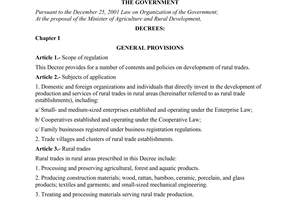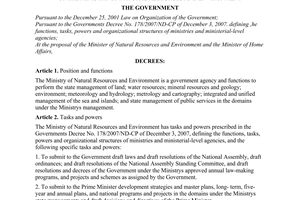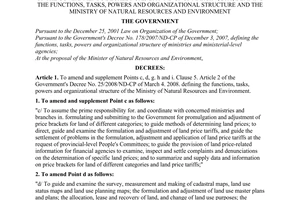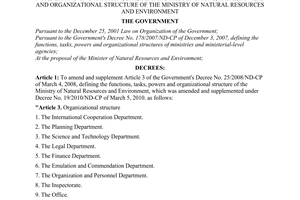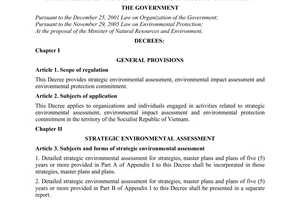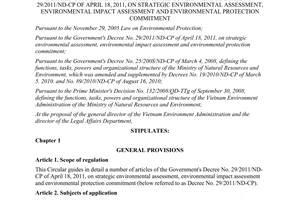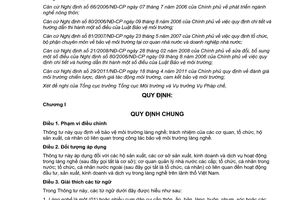Circular No. 46/2011/TT-BTNMT providing for the environmental protection đã được thay thế bởi Circular 31/2016/TT-BTNMT environmental protection industrial clusters service providers trade villages và được áp dụng kể từ ngày 01/12/2016.
Nội dung toàn văn Circular No. 46/2011/TT-BTNMT providing for the environmental protection
|
THE
MINISTRY OF NATURAL RESOURCES AND ENVIRONMENT |
THE
SOCIALIST REPUBLIC OF VIETNAM |
|
No. 46/2011/TT-BTNMT |
Hanoi, December 26, 2011 |
CIRCULAR
PROVIDING FOR THE ENVIRONMENTAL PROTECTION OF CRAFT VILLAGES
Pursuant to the November 29, 2005 Environmental Protection Law ;
Pursuant to the Government 's Decree No. 25/200S/ND-CP of March 4, 2008, defining the functions, tasks, powers and organizational structure of the Ministry of Natural Resources and Environment, which was amended and supplemented by Decree No. 19/2010/ND-CP of March 5, 2010, and Decree No. 89/2010/ ND-CP of August 16, 2010;
Pursuant to the Government's Decree No. 66/2006/ND-CP of July 7, 2006, on the development of rural production and business lines;
Pursuant to the Government's Decree No. 80/2006/ND-CP of August 9, 2006, detailing and guiding a number of articles of the Environmental Protection Law;
Pursuant to the Government's Decree No. 81/2007/ND-CP of May 23, 2007, providing for environmental protection organizations or sections at state agencies and state enterprises;
Pursuant to the Government's Decree No. 21/2008/ND-CP of February 28, 2008.amending and supplementing a number of articles of the Government's Decree No. 80/ 2006/ND-CP of August 9. 2006. detailing and guiding a number of articles of the Environmental Protection Law;
Pursuant to the Government's Decree No. 29/2011/ND-CP of April 18, 2011, providing for strategic environmental assessment, environment impact assessment and environmental protection commitment;
At the proposal of the general director of the Vietnam Environment Administration and the director of the Legal Department.
STIPULATES:
Chapter I
GENERAL PROVISIONS
Article 1. Scope of regulation
This Circular provides for the environmental protection of craft villages and responsibilities of agencies, organizations, production households and related individuals to protect the environment in craft villages.
Article 2. Subjects of application
This Circular applies to production households and production, business or service establishments in craft villages (below referred to as establishments for short); state management agencies at all levels; domestic and foreign organizations and individuals (below referred to as organizations and individuals) involved in investment, production, business and service activities in craft villages in the Vietnamese territory.
Article 3. Interpretation of terms
In this Circular, the terms below are construed as follows:
1. Craft village means one or many population clusters of village, hamlet or similar level in a commune, ward or a township (below-referred collectively to as commune level) engaged in rural production and business lines and handicraft and cottage industry production activities to turning out one or different kinds of products.
2. Craft village environmental protection infrastructure facilities include centralized wastewater treatment areas, common solid and hazardous waste storage places as provided for in Clause 10, Article 3 of the Government's Decree No. 04/2009/ND-CP of January 14, 2009, on incentives and supports for environmental protection activities.
3. Cleaner production means the continuous modification of production processes, products or services to reduce the use of natural resources, restrict the generation of air, water and land environment pollutants and minimize risks for people and the environment.
4. Environment-friendly technology mean a technology which conserves natural resources and minimizes the generation of wastes which pollute the environment and affect human health.
Chapter II
CONTENTS OF ENVIRONMENTAL PROTECTION OF CRAFT VILLAGES
Article 4. Classification of establishments in craft villages
1. Establishments in a craft village shall be classified by production type and environment pollution potential into three (3) groups: Group A, Group B and Group C in Appendix 01 to this Circular.
Group A comprises establishments of production types with low environmental pollution potential, which are licensed to operate in population areas.
Group B comprises establishments of production types involving one or several processes of high environmental pollution potential, which are not permitted to form anew such processes in population areas and, if being in operation, shall be handled according to Article 8 of this Circular.
Group C comprises establishments of production types with high environmental pollution potential, which are not permitted to be newly set up in population areas and, if being in operation, shall be handled according to Article 8 of this Circular.
2. The review and classification of establishments in craft villages must be completed before December 31, 2013. and updated annually.
3. Due to the volatility of craft villages and the naming of production types in craft villages which depends on the specifics of each locality. Appendix 01 will be considered and supplemented when necessary by the Ministry of Natural Resources and Environment in coordination with other ministries, sectors and localities to suit reality.
Article 5. Assessment of craft village environmental pollution levels
The assessment of craft village environmental pollution levels covers the following contents:
1. Collection of statistics on total volumes of wastewater, exhaust gas, common solid wastes and hazardous wastes.
2. Measurement and analysis of the composition and content of pollutants in exhaust gas, wastewater, solid wastes and hazardous wastes; noise and vibration levels, temperature and dust contents in production areas. Observation of the quality of surrounding environment.
The contents of assessment of craft village environmental pollution levels are guided in Appendix 02 to this Circular {not printed herein).
Article 6. Environmental impact assessment and environmental protection commitments
1. Projects on carrying out new production, business and service activities in craft villages must comply with Clause 1, Article 4 of this Circular and provisions on environmental impact assessment and environmental protection commitment in Articles 12 and 29 of the Government's Decree No. 29/2011/ND-CP of April 18, 2011, providing for strategic environmental assessment, environmental impact assessment and environmental protection commitment (below referred to as Decree No. 29/201 l/ND-CP); Circular No. 26/ 2011/TT-BTNMT of July 18, 2011, of the Minister of Natural Resources and Environment, detailing a number of articles of Decree No. 29/201 l/ND-CP (below referred to as Circular No. 26/2011/TT-BTNMT).
2. For operating establishments which have their environmental impact assessment reports and written environmental protection commitments not yet approved or certified, they shall formulate detailed or brief environmental protection schemes and submit them to competent agencies for consideration and approval under current regulations.
Article 7. Environmental protection conditions upon consideration and recognition of craft villages
1. To be recognized, a craft village must satisfy the following environmental protection conditions:
a/ Establishments of Group B or Group C (if any) must comply with Clause 1, Article 8 of this Circular or have a specific plan for relocation from population areas before January 1, 2017, as required in Clause 2, Article 8 of this Circular; at the time of consideration and recognition, the master plans on industrial parks, industrial complexes, husbandry zones and production zones outside population areas have been approved;
b/ All establishments in the craft village have their environmental impact assessment reports, written environmental protection commitments and detailed or brief environmental protection schemes approved or certified by competent agencies; have applied noise, dust, temperature, exhaust gas and wastewater control and proper on-site treatment measures; sort, collect and manage solid wastes and hazardous wastes (if any) according to regulations; commit to observing regulations on financial contributions to environmental protection in general and waste treatment funds in particular;
c/ It has its own environmental protection facilities. In case of the absence thereof, it has a plan for building such facilities according to a specific implementation schedule already approved by competent authorities;
d/ In the village, there are no occurrences of discharge of wastewater, exhaust gas, solid wastes and hazardous wastes, noise and vibration against regulations, which affects environment sanitation and the beauty of public places in the craft village.
2. A recognized craft village is encouraged to meet the following additional conditions:
a/ Having environmental protection self-management organizations.
b/ Having a village code or convention approved by the district-level People's Committee, which contains environmental protection contents.
3. For a craft village already recognized but failing to meet the requirements defined in Clause 1 of this Article, the provincial-level People's Committee shall direct the district-level People's Committee concerned to work out a remedy plan or to consider and remove such village from the local list of craft villages.
Article 8. Measures to handle Group-B and Group-C establishments which are operating in population areas before this Circular takes effect
1. For polluting production processes of Group-B- or -C establishments operating in population areas defined in Clause 1, Article 4 of this Circular, investment must be made in the application of measures for on-site waste treatment up to relevant national technical regulations on environment.
2. Polluting production processes of Group-B or -C establishments for which it is impossible to make investment in the application of measures for waste treatment up to relevant national technical regulations on environment must be relocated into industrial parks, industrial complexes, husbandry zones or production zones outside the population areas according to Article 36 and Clause 4 of Article 46 of the Environmental Protection Law and Circular No. 42/2006/TT-BNN of June 1,2006, of the Ministry of Agriculture and Rural Development. If they cannot be relocated before January 1, 2017, they must terminate their operation.
Article 9. Codes or conventions of craft villages
Codes or conventions of craft villages shall be formulated and implemented under Joint Circular No. 03/2000/TTLT-BTP-BVHTT-BTTUBTUMTTQVN of March 31,2000, of the Ministry of Justice, the Ministry of Culture and Information, the Standing Committee of the Vietnam Fatherland Front Central Committee, guiding the formulation and implementation of codes or conventions of villages, hamlets, population clusters, with their environmental protection contents guided in detail in Appendix 03 to this Circular (not printed herein).
Article 10. Preferential policies applicable to recognized establishments and craft villages
1. To be prioritized in budget allocation and investment in the construction of environmental protection infrastructure under the guidance in the Ministry of Finance's Circular No. 113/ 2006/TT-BTC of December 28, 2006, guiding a number of contents regarding state budget support for development of rural production and business lines under the Government's Decree No. 66/2006/ND-CP of July 7,2006, and other relevant regulations.
2. To be prioritized in environmental protection knowledge training and dissemination for their communities, environmental protection self-management organizations and commune-level environment management officers.
3. To be prioritized in consideration and approval of preferential loans of environment-related credit institutions such as the Vietnam Environmental Protection Fund, sectoral environmental protection funds and local environmental protection funds.
4. To be prioritized in consideration and selection as implementation locations for receipt of waste treatment models and other activities of international projects and state-funded tasks and projects.
Article 11. Information and reporting
1. The People's Committees at all levels, provincial-level Departments of Natural Resources and Environment and establishments in craft villages shall periodically report on environmental protection activities under Chapter TIT of this Circular.
2. Environmental protection information of establishments and craft villages will be publicized in the mass media; notified at meetings of People's Committees and People's Councils of all levels and meetings of population communities or posted up at the offices of the People's Committees of all levels.
Chapter III
CRAFT VILLAGE ENVIRONMENTAL PROTECTION RESPONSIBILITIES
Article 12. Responsibilities of establishments
1. To strictly and fully comply with the contents of the environmental impact assessments, written environmental protection commitments, detailed or brief environmental protection schemes mentioned in Article 6 of this Circular, relevant approval or certification documents and agreements in village codes or conventions (if any).
2. To apply noise, dust, exhaust gas and wastewater control and on-site treatment measures according to regulations; to collect, sort and gather solid wastes to designated places; hazardous wastes (if any) must be sorted, stored and transferred to licensed treatment units according to regulations.
3. To receive and operate according to regulations waste treatment facilities if they are selected for investment with these facilities; to take the initiative in technological inquiry, research and modification, application of environment-friendly production technologies and cleaner and energy-conserving production solutions in production and business activities.
4. To carry out relocation, change production and business lines or comply with handling measures prescribed by law. Relocation costs will be paid by establishments themselves.
5. In case of fire, explosion, chemical leakage, pollution transmission, to immediately report thereon to commune-level People's Committees for timely direction and handling.
6. To contribute funds to the construction, operation, maintenance and renovation of craft village environmental protection infrastructure facilities; to promptly and fully pay charges for solid waste collection, transportation and treatment.
7. To fully and promptly pay environmental protection charges for wastewater, exhaust gas and solid wastes, and other charges and fees according to law.
8. To annually report to commune-level People's Committees on their generation and treatment of wastes before October 15 or irregularly at the request of competent management agencies (according to the form in Appendix 04, not printed herein).
Article 13. Responsibilities of environmental protection self-management organizations
Environmental protection self-management organizations are those set up and operating on the principle of voluntariness and joint responsibility as provided for in Clause 2, Article 54 of the Environmental Protection Law. They shall:
1. Deploy forces, means and equipment for collection and transportation of solid wastes to gathering places according to regulations.
2. Manage, operate, maintain and renovate environmental protection infrastructure facilities as assigned by commune-level People's Committees.
3. Post up regulations and monitor and urge hygienic practices at public places.
4. Formulate and organize the implementation of village codes or conventions with environmental protection contents; propagate and mobilize people to get rid of backward and unhygienic customs and practices detrimental to the environment.
5. Participate in the inspection and supervision of the implementation of regulations on environmental sanitation and protection by establishments in localities as assigned by commune-level People's Committees.
6. Upon detection of abnormal signs of environmental pollution (exhaust gas, wastewater and solid wastes) or environmental incidents or violations of the law on environmental protection in areas under their assigned management, handle them according to their competence or immediately report them to commune-level People's Committees.
7. To report to commune-level People's Committees on their current activities and the collection, transportation and treatment of wastes as assigned annually before October 15 or irregularly upon request (according to the form in Appendix 05. not primed herein).
Article 14. Responsibilities of commune-level People's Committees
1. To perform the state management of craft village environmental protection under the direction and assignment of district-level People's Committees.
2. To propose competent authorities not to permit the establishment of new production chains with high environmental pollution potential, with regard to Group-B or Group-C establishments defined in Clause I, Article 4 of this Circular in population areas.
To participate in the application of handling measures against Group-B and Group-C establishments under Clause 2, Article 8 of this Circular.
3. To urge the inclusion of environmental protection contents in craft village codes or conventions to be submitted to district-level People's Committees for approval.
4. To assign civil servants according to Clause 2, Article 3 of the Government's Decree No. 92/2009/ND-CP of October 22, 2009, on the titles and numbers of and regimes and policies applicable to cadres and civil servants in communes, wards or townships and commune-level part-time officers, to guide establishments and advise commune-level People's Committees on the implementation of regulations on environmental protection in craft villages. Meanwhile, chairpersons of commune-level People's Committees shall sign labor contracts for performance of tasks to support environmental protection; the funds for performance of these labor contracts shall come from non-business environmental protection funds allocated to communes under the Government's Decree No. 81/2007/ND-CP of July 23, 2007, defining specialized environmental protection organizations or sections in state agencies.
5. To use non-business environmental funds according to regulations, concentrating them on activities of craft village environmental protection. To allocate regular funds to support the repair and renovation of craft village environmental protection infrastructure facilities in localities.
6. To organize the management, operation and maintenance of craft village environmental protection infrastructure projects and works according to regulations when they are assigned to receive and manage them.
7. To promulgate operation regulations and create conditions for environmental protection self-management organizations to operate effectively under Clause 3, Article 54 of the Environmental Protection Law.
8. To mobilize contributions from organizations and individuals in their localities for the construction, operation, maintenance and renovation of craft village environmental protection infrastructure works on the principle of democracy and voluntariness. The management of those contributions must be publicized, inspected and controlled so that they are used properly and strictly according to regulations.
9. To inspect and guide establishments to implement environmental protection laws and regulations and handle violations according to their competence; to join teams to inspect and examine establishments in their localities at the request of superior authorities.
10. To propagate and disseminate information on, and raise public awareness of the responsibility for environmental protection; to encourage establishments to collect to the utmost, recycle, reuse and treat on site assorted wastes.
11. To publicize information on the current environmental conditions and craft village environmental protection in local information and communications media, via local mass organizations and socio-political organizations and at meetings of commune-level People's Committees and People's Councils.
12. To report to district-level People's Committees (via the Sections of Natural Resources and Environment) on current activities and the generation and treatment of wastes in craft villages annually before October 30 or irregularly upon request (according to the form in Appendix 06, not printed herein).
Article 15. Responsibilities of district-level People's Committees
1. To investigate, make statistics on and lists of forms of operation of establishments in craft villages according to Group A, Group B and Group C defined in Clause 1, Article 4 of this Circular.
2. To formulate and submit local plans on craft village environmental protection and organize the implementation after they are approved.
3. To prioritize the allocation of non-business environmental funds to recognized craft villages and other state-budget funds for investment in, construction and upgrading of waste treatment works in craft villages.
4. To plan, review master plans on industrial complexes or arrange husbandry zones and production zones outside population areas according to regulations on environmental protection; to invest in and upgrade infrastructure facilities to ensure the relocation of polluting establishments or production processes from population areas under Clause 2, Article 8 of this Circular.
5. To plan and organize the relocation of polluting establishments or production processes from population areas under Clause 2, Article 8 of this Circular.
6. To examine, inspect and organize or authorize commune-level People's Committees to organize registration of written environmental protection commitments and brief environmental protection schemes for establishments in craft villages according to regulations.
7. To direct the formulation of, approve, inspect and monitor the implementation of environmental protection contents in craft village codes or conventions.
8. To propagate and disseminate laws and regulations on environmental protection to administrations, environmental protection self-management organizations and population communities in communes with craft villages; to organize activities that encourage establishments to apply cleaner production solutions and environment-friendly technologies and collect and recycle wastes.
9. To publicize information on the current environmental status and environmental protection of craft villages in local information and communications media and at meetings of district-level People's Committees and People's Councils.
10. To direct district-level Sections of Natural Resources and Environment to summarize current activities and the generation and treatment of wastes in craft villages in their localities and report thereon to provincial-level People's Committees (via provincial-level Departments of Natural Resources and Environment) annually before November 15 or irregularly upon request (according to the form in Appendix 07, not printed herein).
Article 16. Responsibilities of provincial-level People's Committees
To direct provincial-level departments, sectors and district-level People's Committees to implement the craft village environmental protection contents in localities, specifically:
1. To work out local master plans on development of rural production and business lines in compliance with environmental protection regulations.
2. To assess craft village environmental pollution levels, to plan and invest in pollution treatment.
3. To plan and invest in the construction of environmental protection infrastructure facilities for recognized craft villages. To direct the planning and investment in the construction of infrastructure of industrial parks, industrial complexes, husbandry zones and production zones outside population areas up to environmental protection requirements for relocation of polluting establishments or production processes from population areas according to Clause 2, Article 8 of this Circular.
4. To prioritize the allocation of local budget funds and other financial sources for craft village environmental protection activities. To prioritize the allocation of non-business environmental funds to communes, wards and townships with recognized craft villages for carrying out environmental protection activities under the guidance in Joint Circular No. 45/ 2010/TTLT-BTC-BTNMT of March 30, 2010, of the Ministry of Finance and the Ministry of Natural Resources and Environment, guiding the management of non-business environmental funds.
5. To manage the collection, transportation, recycling and treatment of rural wastes, including wastes arising from activities of establishments in craft villages.
6. To investigate, detect and handle violations of the environmental protection law committed by establishments in craft villages.
7. To disseminate experience and provide training and information on environment-friendly production, management, science and technology, or organize exhibitions, trade fairs to advertise environment-friendly products to establishments in craft villages.
8. To publicize information on the current environmental status and environmental protection of craft villages in local information and communications media and at meetings of provincial-level People's Committees and People's Councils.
9. To organize the recognition of craft villages according to Article 7 of this Circular.
10. To formulate, promulgate or submit to competent authorities for promulgation regulations and policies on support for establishments to be relocated from population areas or change their production and business lines.
Article 17. Responsibilities of provincial-16vel Departments of Natural Resources and Environment
1. To assume the prime responsibility for. and coordinate with district-level People's Committees in, investigating and assessing the levels of craft village environmental pollution; to formulate plans, solutions and roadmaps for environmental protection and treatment of environment pollution in craft villages in their provinces, and submit them to provincial-level People's Committees for approval, and organize the implementation thereof.
2. To coordinate with related provincial agencies in planning the development of rural production and business lines in accordance with regulations on environmental protection.
3. To coordinate with provincial-level Departments of Finance in allocating non-business environmental funds to localities with craft villages, and monitor and inspect the use thereof.
4. To coordinate provincial-level Departments of Science and Technology and Departments of Industry and Trade in providing technical assistance for waste treatment and techniques for applying environment-friendly technologies, and cleaner and energy-conserving production solutions.
5. To assume the prime responsibility for, or coordinate with provincial-level Departments of Health, Departments of Industry and Trade, district-level People's Committees, commune- level People's Committees, socio-political organizations, associations and population community representatives in, propagating and educating in, and raising awareness of, craft village environmental sanitation and protection.
6. To organize the collection of environmental protection charges for wastewater, exhaust gas and solid wastes from establishments in craft villages according to regulations.
7. To appraise environmental impact assessment reports and detailed environmental protection schemes of establishments in craft villages according to their competence; to conduct the observation of craft village environment.
8. To assume the prime responsibility for, or coordinate with district-level and commune- level People's Committees in, organizing the inspection, examination and guidance of the implementation of the environmental protection law by establishments in craft villages according to their competence. To oversee the publicity of information on craft village environmental protection in localities.
9. To report to the Ministry of Natural Resources and Environment on current activities and the generation and treatment of wastes in craft villages in their localities annually before December 30 or irregularly upon request (according to the form in Appendix 08, not printed herein).
Chapter IV
ORGANIZATION OF IMPLEMENTATION
Article 18. Effect
This Circular takes effect on March 1, 2012.
Article 19. Implementation responsibility
1. Ministers, heads of ministerial-level agencies, heads of government-attached agencies and chairpersons of People's Committees at all levels shall organize the implementation of this Circular.
2. The general director of the Vietnam Environment Administration shall inspect and urge the implementation of this Circular.
3. Any problems arising in the course of implementation should be reported to the Ministry of Natural Resources and Environment for study, appropriate amendment and supplementation.-
|
|
FOR
THE MINISTER OF |
APPENDIX 01
CLASSIFICATION OF ESTABLISHMENTS IN CRAFT VILLAGES
BY PRODUCTION TYPE AND ENVIRONMENTAL POLLUTION POTENTIAL
(Promulgated together the Ministry of Natural Resources and Environment's
Circular No.46/20U/TT-BTNMT of December 26, 2011, providing for the
environmental protection of craft villages)
1. Group A comprises establishments engaged in the following production and business lines:
- Production of handicraft and fine-art articles or household articles (bamboo and rattan articles; conical hats, rush mats, brooms; "do" (rhamnoneuron) paper; pulp, water coconut leaf threads; embroidery, lacing, weaving; joss-sticks; fine-art articles from coconut and dry marine shells): excluding processes of soaking, boiling, steaming, drying, painting, surface polishing with chemicals;
- Textile: excluding processes of dyeing, washing, grinding, cleansing, yarn starching, using raw materials and generating wastewater;
- Traditional casting and forging of farm tools and household utensils: under 0.3 tons of products/day;
- Thread/plastic cable rolling/plaiting: excluding processes of producing, pushing out and pressing plastics;
- Silkworm raising: excluding the process of cocoons unwinding;
- Ornamental animal and plant culture;
- Starch processing: under 0.1 ton of products/day;
- Mechnical processing with machines: under 0.3 ton of products/day;
- Regular domestic animal or poultry rearing on the following scale:
+ Buffaloes, cows, horses: under 5 heads for reproductive, cross-breeding, milking raising; under 10 heads for beef raising;
+ Pigs: under 10 heads for reproductive and cross-breeding rearing; under 20 heads for porker rearing;
+ Goats, sheep, dogs: under 50 heads;
+ Rabbit: Under 100 heads;
+ Poultry: under 100 heads; quails: under 1,000;
- Regular slaughter on the following scale:
+ Domestic animals: Under 01 ton/day;
+ Poultry: Under 0.5 ton/day.
2. Group B comprises establishments engaged in the following production and business lines with environmental pollution potential:
- Charcoal pits: processes of timber burning and pitting;
- Cocoon unwinding: processes of cocoons unwinding and silk spinning;
- Farm produce and food processing (manual production of cane sugar, preserved fruits, confectioneries; manual production of fish sauce, fish and shrimp pastes, soy sauce; production of rice noodle and pancakes of different kinds; alcohol distillery): processes of cleaning, preliminarily processing raw materials; processes involving the use of fuel such as coal, firewood or rice husk to change the composition and characteristics of raw materials; processes emitting strong and stinking smells);
- Processing/preliminary processing of aquatic/marine products: processes of cleaning and preliminarily processing raw materials; processes involving the use of fuel (coal, firewood and rice husk) to change the composition and characteristics of raw materials; processes emitting strong and stinking smells;
- Production of fine-art articles (stone, wood, metal or gemstone fashioning; production of porcelain or lacquer articles): process of preparing raw materials/shaping products which causes dust or bad smell; process of using chemicals for surface treatment; process of soaking or boiling for treatment of raw materials and products; process of drying or baking with coal, firewood or rice husk;
- Glass production: process of boiling.
3. Group C comprises establishments engaged in the following production and business lines:
- Production of building materials: lime, bricks, tiles, sawn rocks;
- Classification, cleansing and recycling of paper;
- Classification, cleansing and recycling of metals;
- Classification, cleansing and recycling of plastics;
- Dyeing with industrial dyes; -Leather tanning:
- Electroplating or wet-plating;
- Preliminary processing of rubber latex (coagulation);
- Starch processing: 0.1 ton of product/day or more;
- Mechanical processing with machines: 0.3 ton of products/day or more;
- Regular raising of domestic animals and poultry on the following scale:
+ Buffaloes, cows, horses: 5 heads or more for reproductive, cross-breeding, milking raising; 10 heads or more for beef raising;
+ Pigs: 10 heads or more for reproductive and cross-breeding rearing, 20 heads or more for porker raising;
+ Goats, sheep, dogs: 50 heads or more;
+ Rabbit: 100 heads or more;
+ Poultry: 100 heads or more; quail: 1,000 or more;
- Regular animal and poultry slaughtering on the following scale:
+ Animals: 01 ton/day or more;
+ Poultry: 0.5 ton/day or more.-

